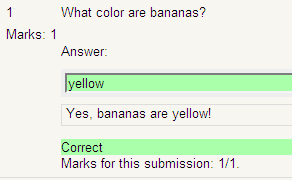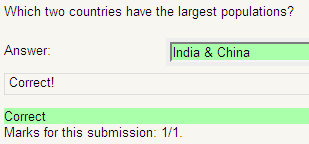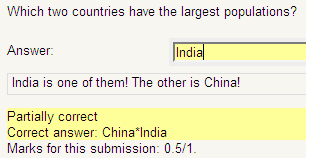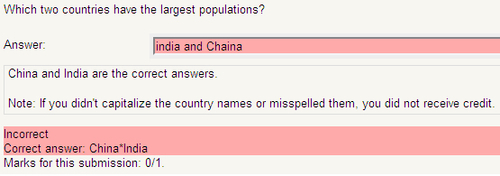We have already looked at True/False and Multiple Choice options in Quiz. Now, we are going to take a look at each of the remaining question types in Quiz. We will work together to create questions in each of them and then you will work alone to make questions for each format. Now, let's get to work and make some more questions.
In this chapter, we will:
- Look at the remaining question types
- Create questions for each item type
- Pursue Self-development activities
- Discuss considerations for each question type
Short Answer questions were briefly described earlier, but just so we all remember, short answer items are where the test taker writes a short response in a textbox. This option can be used either to answer a question or as a gap-fill activity. The test taker's response must be exactly the same as the one you entered or one of the alternative options you have made available, or the answer will be counted incorrect. In this section, we will look at how to make short answer items and use some of the options available. Once we have finished looking at how to set one up, you will create one on your own.
Tip
Gap-Fill Activity
If you are using Short Answer for a gap-fill type question, here is a good idea. Use underscores to show where the gap will be when writing your question title.
First we need to go through the basic steps of creating a question, as we saw in Chapter 1. We need to go to the Question Bank page and create a new Short Answer item. If you have administration privileges, you can get directly to the Question Bank via the Course Administration block by clicking on the Questions link. Alternatively, you can open a previously created quiz and access the Question Bank. as we did in Chapter 1.
Now, we need to complete the General section of the question. This process is identical to that of the previous questions we have created. We need to make sure the category is set to where we want the question located, give the question a name, and write the question text. Here, we also have the option of inserting any uploaded images, giving general feedback, or adjusting the points received for a correct answer to the question.
The question we are going to ask is, Who was the first person in space?, and we will use this text for both the question description and the question text. We won't be giving any general feedback and we won't be making any changes to the default settings.
There is one new option available in the General section of Short Answer. Is it called Case Sensitivity. This menu allows you to set whether you will require capitalization or not. This option is something you will have to decide for each question you create, depending on how important case is to you, your students, and what you are teaching. If case isn't that important, then you might want to leave it set to No, case is unimportant'. However, if you are working on something where the case is important, then you might want to have this option set to Yes, case must match. It all depends on your needs.
For our question, since we are talking about a person, the name should be capitalized, and so we could set Case Sensitivity to Yes, case must match. However, we are more concerned that the students know the answer, not whether they remember to capitalize, therefore, we're going to leave it set to No, case is unimportant.
Now, we need to enter my answer into the Answer textbox. We type in the name of the person, Yuri Gagarin, in the Answer textbox, change the grade from None to 100%, and we're going to give some feedback in the Feedback area. The only correct response for this item will be Yuri Gagarin, with the case being ignored.
This is all I have to do to create the question. Let's stop here and review the question to make sure we have done everything correctly and then save the changes.
We will now preview the question to make sure it looks the way we want it to. It looks fine, so we will go ahead and type in the correct answer first, then click on the Submit all and finish button. This sequence will show us the grade and feedback we get from the response, as shown in the next screenshot:

This question looks like what we want it to and we should be happy with the display and the feedback. However, some of the students might enter Gagarin instead of Yuri Gagarin. If they do this, their response will be marked incorrect. They also might enter Y. Gagarin or some other combination, which we need to consider and account for.
What we need to do now is go back to the Edit question page. Clicking on the Edit icon next to the question in the Question Bank will bring us to the Editing page. Now we can enter any other responses we are willing to accept. I have already gone back and entered several different variations on Yuri Gagarin's name, copied and pasted the feedback from the original response, and given a 100 percent score for each of the alternative responses. Now if a student responds with any of the variations of the name entered, it will be scored as correct, given full points, and receive correct response feedback.
We have entered seven variations of the Gagarin name; there may be one or more that we overlooked but feel should get credit. So, even though we have several different possible responses, students will still make mistakes, in spelling or simply enter the wrong person's name. Here is an example of a simple spelling mistake.

As you can see, there is no feedback given for the incorrect answer. If we want to give feedback for a wrong response in Short Answer, we should create the final answer option with * in its Answer line.
The * symbol added to an answer textbox is what Moodle terms a wildcard. Wildcards are used to match a series of letters or characters and are also used for offering feedback for incorrect responses. We need to use wildcards because there may be spellings, combinations, or other factors you may not have considered. For example, let's say we entered a wildcard with letters on either side, y*n. This wildcard would match anything that began with a y and ended with an n: yon, Yuri Gagarin, Y. Gargin, yellow fan, and others. If we entered only one letter and a wildcard, say s*, it would match anything beginning with an s: Silly, sad, Spain, ssssss, and so on. A wildcard entered without any characters attached allows us to set feedback for incorrect answers.
Anything other than the correct responses you entered will be viewed as an incorrect response and will receive no grade. However, if you enter an * into the last Answer textbox, the feedback entered there will be displayed to anyone who does not respond with one of the correct options. It is important to note that the wildcard must be entered into the last answer, or it will not work properly.
Here is another example of a wrong response, but this time I have added the * to the final answer text and added some incorrect response feedback.

As you can see, now, when someone enters anything other than the correct response, he or she will receive the feedback shown in the previous screenshot.
Obviously, we can only enter a small number of variations into the system. It would simply take too long to enter a full range of variations on an answer. If we use the asterisk, or wildcard we are able to accept a range of responses as correct.
The first way to use the wildcard is for spelling issues. If we aren't particularly worried whether or not a student can spell the response correctly, we can set up the response parameters to accept a variety of spellings.
If we have a question regarding polyhydroxyalkanoates (a linear polyester), maybe we aren't too worried if there is a mistake in spelling. What we can do is create an acceptable starting and ending point for the word. For example, we want them to have the poly correct and we feel they should be able to end with ates. If these were our requirements, we would simple enter poly*ates into the answer text. This would mean that students who wrote an answer that began with poly and ended with ates would have it marked correct.
This is a variation on the spelling rule outlined previously. If we ask the question, What are the two main political parties in the US?, we would expect the students to answer with something like Democrats and Republicans. However, they may write it in a different order, or with an ampersand (&), a comma, a space, or some other way. We are willing to accept several variations because the question is simply seeking to know whether the student knows the two major parties in the US political system. Our first option is not using the wildcard. This option forces us to manually enter several variations, and we also run the risk of missing some of the possible variations.
The other option is to use the wildcard. By creating the wildcard function, such as Democrats*Republicans, any variation will be accepted. Democrats and Republicans; Democrats & Republicans; Democrats, Republicans; Democrats + Republicans; and so on. It would even accept as a correct answer Democrats are the best party available for the people (although I really wish there was a strong Independent Party) but unfortunately we still have to deal with the Republicans, because, Democrats comes first and Republicans comes last. This function can be very useful, but it does have its limits, as you can see.
If you wanted to give credit for partial answers, you can do that as well. For example, you could set up your answers as follows:
- Democrats*Republicans—Answer 1 100%
- *Democrats* - Answer 2—50%
- *Republicans* - Answer 3—50%
- *—Answer 4 0%
It is important to enter your responses in the order you want them evaluated, because Moodle looks at the responses starting with Answer 1 and moves down the list until it finds one that matches. This is the reason why the wildcard is always located at the end of the answer options.
We are going to prepare two Short Answer questions together. The first one will be a simple, single-word response. The second will use the wildcard feature.
- Create a new quiz with a title Short Answer. Leave all the settings to default but turn off the Adaptive mode.
- Go to Editing tab and, in the Question Bank, make sure your category is set to Default for Short Answer.
- Go to Create a new question and select Short Answer from the drop-down.
- For Question name and Question text, enter the same thing: What color are bananas?
- Leave all the settings as they are and make sure the Case Sensitivity is set to No, Case is Unimportant.
- In Answer 1, write yellow in the Answer textbox. For grade, change None to 100%. In feedback enter, Yes, bananas are yellow!.
- We are only going to accept yellow and we are only going to accept it if it is spelled correctly. So, for Answer 2, please enter an * in the Answer textbox. Leave Grade set to None. In the feedback, enter:'Sorry, but bananas are yellow.
- When you have finished, go to the bottom of the page and click on Save changes.
- You will be brought back to the Question Bank and you will see your newly made question. Click on the Preview icon, the one that looks like a magnifying glass, and you will see the question we just made. It should appear as shown in the following screenshot:

If you can see the previous screenshot in your preview, you have done everything correctly! Well done! Now, we want to check your responses to make sure they are the way you wanted them. The correct response will look like the next image on the left-hand side and any other response should look like the one on the right.

For this one, we are going to use a wildcard to accept several different answers.
- In the quiz we have already created, create a new Short Answer question.
- Title it Which two countries have the largest populations? Use the same for the question text.
- Leave all the options as default, except for Case Sensitivity. This time we want our students to use the correct case the names of countries are proper nouns. Change the setting to Yes, case must match.
- Now we need to put our answers in the textboxes. We want to offer two possible correct answers to our students. In Answer 1's textbox, enter China*India. In Answer 2's textbox enter India*China.
- This set-up will allow students to enter both countries in any order and with any conjunction, symbol, punctuation, or anything else separating the words.
- We also need to change the grade for each of these options from None to 100%. Also, for feedback, we will add a simple Correct!.
- I have decided that we want to give half-credit if the students can get one of the answers. Go ahead and click on the Blanks for 3 more choices button towards the bottom of the page. In Answer 3 enter *China*. In Answer 4 enter *India*. This set-up will give partial credit if the student enters China or India.
- For the grade, I will change the value from None to 50%.
- For Answer 3 feedback, we will write India is one of them! The other is China. For Answer 4 feedback, we will reverse the order.
- In Answer 5, we will enter *. This wildcard value will give feedback to the students for any other response. The grade will remain as None, and for feedback, we will enter China and India are the correct answers.
- We will also add a short note telling the students that if they forgot to capitalize the country names or spelled them wrong, the answer was counted incorrect. This explanation will also help cut down on students coming to you telling you they got the answer correct, but the computer marked it wrong. This text is what we will include in the Feedback: Note: If you didn't capitalize the country names or if you misspelled them, you did not receive credit.
- Now click on Save changes. Preview the question and you should see the question and a blank textbox.
- Now, answer the question using a correct response, a partially correct response, and an incorrect response.
- The screenshot of the correct response is as follows:

- The screenshot of the partially correct response is as follows:

- Finally, the screenshot of the incorrect response is as follows:

You can see that all forms are working as we want and the scoring and feedback is correct.
Where should we use Short Answer? Well, we want to use Short Answer when we are looking for students to know an answer, and not just recognize it from a list of possible choices.
We also want to use simple answers in the Short Answer questions. If you create a long string of text, it is more difficult for students to get the correct answer, because the text might not match exactly or closely enough to the predetermined parameters. This situation is something to avoid. One-to two-word strings are probably most useful here; three is starting to push it. If the strings are longer, you run the risk of giving students inappropriate grades based on a slight difference in the response phrasing, for example, if a student had entered India, Russia, America, Turkey, China in the previous example, the answer would have been scored as correct, although, it is clearly wrong.
Additionally, after the student responds, he or she will see the correct response listed. The first correct response the system encounters will be used and displayed. So, using our previous example, if a student got the answer correct, he or she would see something like democrat*republican displayed in the Correct Response area. This point is not that important, but something you should be aware of as you may need to explain it to your students.
